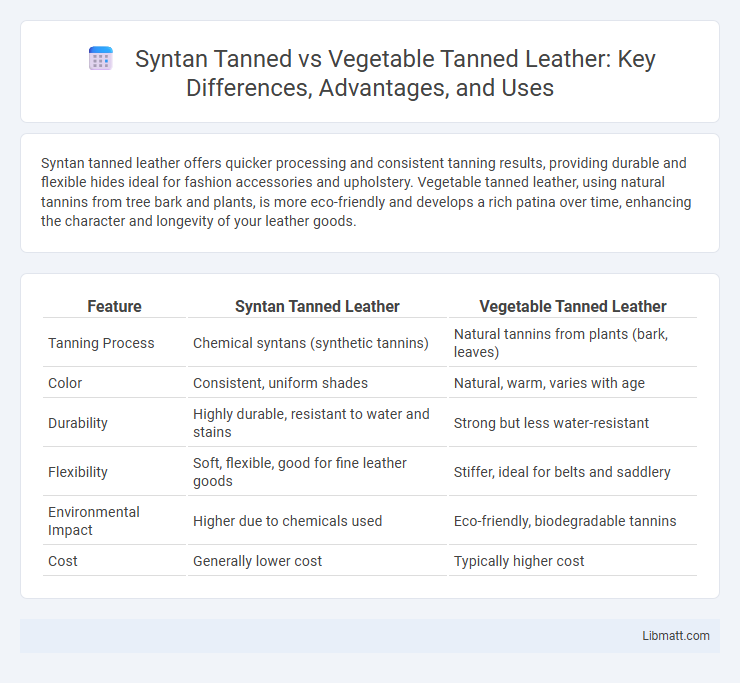Syntan tanned leather offers quicker processing and consistent tanning results, providing durable and flexible hides ideal for fashion accessories and upholstery. Vegetable tanned leather, using natural tannins from tree bark and plants, is more eco-friendly and develops a rich patina over time, enhancing the character and longevity of your leather goods.
Table of Comparison
| Feature | Syntan Tanned Leather | Vegetable Tanned Leather |
|---|---|---|
| Tanning Process | Chemical syntans (synthetic tannins) | Natural tannins from plants (bark, leaves) |
| Color | Consistent, uniform shades | Natural, warm, varies with age |
| Durability | Highly durable, resistant to water and stains | Strong but less water-resistant |
| Flexibility | Soft, flexible, good for fine leather goods | Stiffer, ideal for belts and saddlery |
| Environmental Impact | Higher due to chemicals used | Eco-friendly, biodegradable tannins |
| Cost | Generally lower cost | Typically higher cost |
Introduction to Leather Tanning Methods
Vegetable tanned leather uses natural tannins from tree bark and plants, producing a firm, durable material with a rich patina over time. Syntan tanned leather involves synthetic chemicals that allow for faster processing and more consistent color and texture throughout the hide. Your choice depends on whether you prioritize traditional craftsmanship and aging qualities or efficiency and uniformity in leather goods.
What is Syntan Tanned Leather?
Syntan tanned leather is produced using synthetic tanning agents, primarily based on synthetic organic compounds such as syntans, which provide faster processing times and more uniform leather characteristics compared to traditional methods. This tanning method results in leather with improved colorfastness, increased softness, and enhanced resistance to water and abrasion, making it suitable for various leather goods and fashion applications. Unlike vegetable tanned leather, which uses natural tannins from plant sources, syntan tanned leather offers greater control over the tanning process and consistency in quality.
What is Vegetable Tanned Leather?
Vegetable tanned leather is crafted using natural tannins extracted from tree bark, leaves, and other plant materials, resulting in a durable, eco-friendly, and biodegradable product. This tanning method enhances the leather's rich, warm tones and allows it to develop a unique patina over time, making each piece distinct. You will appreciate its firmness and ability to mold to shapes without compromising strength compared to syntan tanned leather, which uses synthetic tanning agents.
Manufacturing Process Comparison
Syntan tanning utilizes synthetic chemicals derived from petrochemical sources, enabling faster processing times and more consistent leather quality compared to vegetable tanning, which relies on natural tannins extracted from tree bark, leaves, and fruit peels. The syntan manufacturing process involves controlled chemical reactions that reduce water usage and waste generation, whereas vegetable tanning requires prolonged soaking and multiple baths, often lasting several weeks. These differences result in syntan-tanned leather being more uniform and quicker to produce, while vegetable-tanned leather offers traditional craftsmanship with a more environmentally friendly but time-intensive process.
Physical Properties: Syntan vs Vegetable Tanned
Syntan tanned leather exhibits enhanced flexibility, uniform color absorption, and superior resistance to water and UV exposure compared to vegetable tanned leather. Vegetable tanned leather is known for its firmness, natural texture, and excellent breathability, though it tends to be less flexible and more prone to water damage. In terms of durability, syntan leather maintains consistent physical properties under varying conditions, whereas vegetable tanned leather develops a rich patina and softens over time through natural wear.
Environmental Impact and Sustainability
Syntan tanned leather, derived from synthetic chemicals, often involves petrochemical-based compounds that can release harmful pollutants and require significant energy consumption, raising concerns about environmental impact. Vegetable tanned leather utilizes natural tannins from tree bark and plant extracts, offering a biodegradable and less toxic alternative, making it more sustainable and eco-friendly in comparison. The biodegradability and renewable sourcing of vegetable tanned leather contribute to reduced ecological footprint, promoting a circular economy in leather production.
Durability and Aging Characteristics
Syntan tanned leather offers enhanced durability due to its synthetic tanning agents, making it more resistant to water, stains, and abrasion compared to vegetable tanned leather. Vegetable tanned leather develops a rich patina over time, showcasing natural aging characteristics such as color darkening and texture softening, which many users value for its authenticity. While syntan tanned leather maintains consistent appearance and strength, vegetable tanned leather reflects unique, evolving aesthetics through prolonged use.
Applications and Typical Uses
Syntan tanned leather is widely used in producing smooth, flexible items like automotive upholstery, fashion accessories, and garments due to its consistent texture and color retention. Vegetable tanned leather is preferred for durable products such as belts, saddles, and wallets because of its firm structure and ability to develop a rich patina over time. Your choice depends on the desired flexibility and aging characteristics for specific applications.
Aesthetic and Sensory Differences
Syntan tanned leather offers a consistent color palette and smooth texture with a slightly glossy finish, creating a uniform and polished appearance. Vegetable tanned leather exhibits rich, natural variations in tone and texture that develop a unique patina over time, enhancing its character and sensory appeal. Your choice between syntan and vegetable tanning affects the tactile experience and visual depth of the leather, influencing both durability and aesthetic authenticity.
Choosing the Right Leather for Your Needs
Syntan tanned leather offers superior water resistance and flexibility, making it ideal for durable, everyday items like bags and shoes, while vegetable tanned leather is prized for its natural aging and rigidity, perfect for belts and wallets that develop a unique patina over time. You should consider your product's intended use, desired finish, and environmental impact when choosing between syntan and vegetable tanning processes. Vegetable tanned leather uses natural tannins from tree bark, providing eco-friendly benefits, whereas syntan tanning often involves synthetic chemicals that give enhanced performance characteristics.
Syntan tanned vs vegetable tanned Infographic

 libmatt.com
libmatt.com